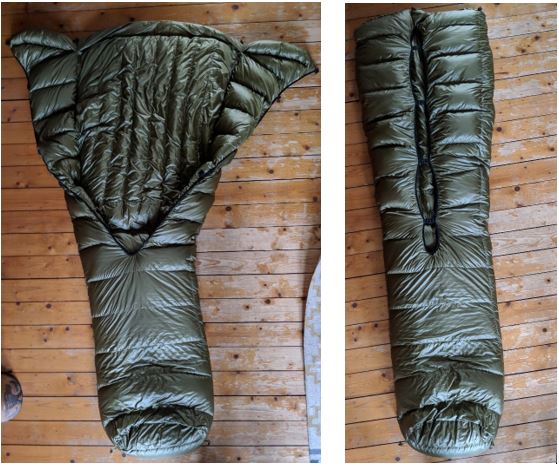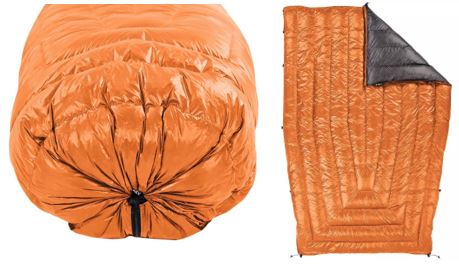Quilt: what is it and what are the pros and cons?

In my previous Pacific Crest Trail preparation blog post, I took a closer look at my Big 4. One of the gear items I changed out to lighten my pack was my synthetic sleeping bag, which I replaced with a down quilt from Cumulus. In this article I elaborate further on what a quilt is and what the advantages and disadvantages of a quilt are compared to a traditional sleeping bag. Like the majority of typical lightweight hiking equipment, I have never seen a quilt for sale in the Netherlands. In fact, I had never heard of it until I started preparing for the Pacific Crest Trail a few months ago. However, in the US, a quilt is omnipresent on long-distance trails. For example, a survey of Appalachian Trail hikers in 2017 found that 27% of the respondents used a bag from Enlightened Equipment, arguably the best-known quilt manufacturer. Their model “Revelation” was the choice of no less than 20% of all respondents. The 2018 survey also shows this: 29% of hikers used a quilt on the Appalachian Trail in 2018. A survey of PCT hikers in 2018 also confirmed the popularity of quilts: the two most commonly used sleeping bags for the PCT in 2018, among those surveyed, were both quilts, with a hybrid sleeping bag (in between a quilt and a regular sleeping bag) taking third place. You can read all findings of the survey here (for the AT 2017), here (for the AT 2018), and here (for the PCT 2018).
Quilts originate from the hammocking world, where a top quilt and an underquilt are used. The idea behind a quilt is that a regular sleeping bag is stripped down from all its unnecessary features, without creating a loss of warmth. A quilt then has no hood, no zipper and an open part at the back, which is shown in the images at the beginning of this blog post. Although the lack of insulation on the bottom of the quilt seems to imply a lot of heat loss, this is not the case: down insulates well, but only when air is trapped between the down feathers. This trapped air is visible in down products, because it creates the “inflated”, fluffy down chambers that you can easily recognize in sleeping bags or down jackets. If the down is compressed however, it will lose much of its insulation. With a regular sleeping bag insulation will be lost as the down on the bottom of the sleeping bag is compressed by the person lying in the sleeping bag. Building on this idea, the top quilt was created in the hammocking world. This could then be combined with a pad that you put in the hammock or with an underquilt underneath the hammock to have enough insulation from all sides. Since a hammock hangs off the ground, adding an underquilt, which is basically a down blanket, can be hung underneath the hammock without the down being compressed. This allows a hammock set-up to be used at very low temperatures.
This underquilt is useless for ground sleeping though: losing heat to the ground must be prevented by using the right sleeping pad. Depending on the circumstances and temperatures of your hike, the insulation value of your sleeping pad can be very important. To get a good idea of the warmth of a sleeping pad, the R-value, which indicates the insulation value of the pad, is examined. The higher the R-value, the better the mat insulates and the more adequate it is to be used at lower temperatures. In addition, R-values of different pads can simply be added together if several mats are combined. When a pad with an R-value of 2 and a pad with an R-value of 4 are used together and laid on top of one another, this combination has an R-value of 6. This would mean this combination is warm enough to use in very cold, wintery conditions. For three-season use, an R-value between 2 to 3.5/4 should be sufficient. One thing to keep in mind regarding R-values is however that not every manufacturer calculates them; some manufacturers simply estimate their R-value, while others don’t use an R-value at all and indicate a temperature rating (comparable to most sleeping bags). Moreover, such temperature ratings are, much like the ones used for sleeping bags, often exaggerated. This can make comparing sleeping pads difficult. Ultimately, it’s therefore always recommended to do a test hike to find out whether the intended sleeping pad meets all your demands and wishes.

Now we explained what a quilt is, we will turn our focus toward the pros and cons of using a quilt.
The biggest advantage of a quilt over a sleeping bag is weight saving. A down quilt is easily at least 200 grams lighter than an equivalent sleeping bag (similar temperature rating and similar amount of down fill). This is due to the open bottom and the lack of both a zipper and a hood. Since there is no cover for the head, it is common, especially during colder nights, to wear a beanie or balaclava at night. However, since a large part of your body heat is lost through your head, wearing a hat or beanie is always a good idea, also for warmer nights.
A second advantage is the versatility of a quilt compared to a sleeping bag. This advantage is particularly evident with a quilt with an optional footbox. The footbox is the bottom part of the quilt where the feet are placed. Commonly, two footbox-options are available in a quilt: a sewn footbox, which is warmer, making it more suitable for colder temperatures, or an optional footbox that can be opened. Usually such an optional footbox is opened and closed with a zipper or several buttons and can be cinched down at the bottom with an elastic. Consequently, this prevents cold air flows from entering the quilt through the footbox, although it generally loses a bit more warmth than a sewn footbox. However, the advantage of the optional footbox is that it can be fully opened and unfolded into a blanket for the warmer nights, as is shown in the images below.
Lastly, a quilt gives some people a bigger sense of freedom, because you are less enclosed in a “cocoon” than with a sleeping bag and generally have a wider range of motion. Therefore, multiple people who toss and turn a lot during their sleep, prefer using a quilt. To prevent the quilt from rotating too much or coming off the sleeping pad, the quilt can be attached to the sleeping pad with special attachment straps that come with a quilt. I do think that this wider range of motion is very personal though and therefore it can be considered either a pro or a con.
There are also disadvantages of sleeping in a quilt. Firstly, because a quilt is not completely closed, it is less suitable for more extreme temperatures. The chances of cold air flows entering the quilt and losing hot air in the quilt are definitely higher due to the opening at the back. As it gets colder, using a sleeping bag might be smarter then. It is hard to say at which temperature exactly the turning point/limit lies: it depends on several factors such as the pad (and its R-value), the skill of the sleeper being able to keep the opening of the quilt and the quilt itself in place, and whether the person is a hot or a cold sleeper.
If you are not sure and convinced about a quilt, but want to try something a bit lighter than a regular sleeping bag, there is another interesting option: a hybrid between a sleeping bag and a quilt. This is basically a sleeping bag without a hood or a quilt with a zipper, whichever you prefer. Such a hybrid sleeping bag is lighter than a sleeping bag, although less than with a quilt because of the zipper, while it is better enclosed and protected against heat loss than a quilt. Depending on what you are looking for, there appears to be quite some choice in the field of sleeping bags: quilts for people who are looking for the lightest option, sleeping bags as the warmest option and a hybrid sleeping bag that combines the best of both worlds in a happy medium.
Personally, I will bring a quilt on the Pacific Crest Trail, mostly triggered and convinced by its low weight. Apart from that, me being a gear geek definitely plays a part as welI, since I enjoy discovering and testing new gear (developments). I have never slept in a quilt before and I am curious how sleeping in a quilt for every night in various circumstances on the Pacific Crest Trail will work out.
If you would like to learn some more about sleeping pads, R-values and quilts, I can recommend the links below:
- https://thermarestblog.com/r-value-meaning/
- https://thermarestblog.com/how -warm-is-a-sleeping-pad-r-value-vs-degree-ratings/
- https://www.thehikinglife.com/2017/11/why-choose-a-quilt-over-a-sleeping-bag/
- https://www.youtube.com/watch?v=brOqkhV9avY
- https://www.youtube.com/watch?v=tdSgnwdUBT4
Thanks for reading and hopefully I see you soon!
Strooky

